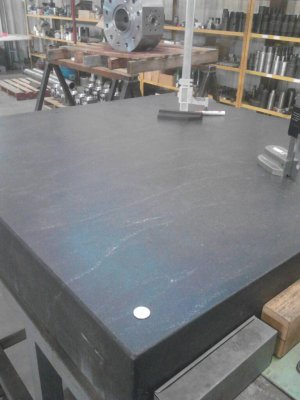A little off topic, but since your goal is tramming your mill, I
strongly recommend building a dedicated tramming tool / spindle square with two dial indicators. It's a quite simple and inexpensive project to build one, and it is
amazingly easier and less work to tram your mill once you have one. I'll never go back. There's little reason to buy a commercial spindle square when it's so easy to build one out of scrap and a couple of cheap harbor freight dial indicators. There's a pretty good YouTube video available from "Metal Tips and Tricks" that shows how to build one:
Swinging a single indicator back and forth when tramming used to drive me nuts: "Lessee, off by 0.010. Whack the head halfway and re-zero. Swing around to the other side. What?!! I'm still off by 0.004. Wait, which way am I out?" When I finally think I've got it, the final torquing of the head bolts would knock it out of tram again, of course!
The headache (for me at least) with a single indicator was primarily due to two problems: "bilateral ambiguity" and basic trigonometry. The first problem is that the indicator faces you when you have it positioned on one side, and faces away from you when swung it to the other side. As silly as it sounds, this caused me enough mental friction that at least half the time I'd whack the head in the wrong direction as I was tramming. The other problem is that it's a non-linear process. Since the bottom of the quill is following an arc, when it's out of tram the high side will indicate a larger distance than the low side. If I re-zeroed each 180 degree swing I'd invariably confuse myself.
A spindle square with an indicator on each side of the quill makes it trivial: just knock the head about until both indicators read the same value. It's even easier to game the process of torquing the bolts down without knocking it out of tram (as you get close start torquing down the bolts — the last couple whacks take a fair of strength to move the head back into tram, but the final torque doesn't move it out of tram). Seriously, being able to see the deviation on both sides at once makes all the difference in the world.
It's trivial to calibrate the tool: just make a mark on your table next to the indicator plunger, zero the dial, turn the spindle so the other indicator is now over the same mark (without touching anything else), and then zero the other indicator.
With the tool, I've found no reason not to measure from the table directly (or from the reference surface at the bottom of my vice). Just move the table in Y so the indicator plungers aren't over a gap.
Honestly, if I ever lose or break this tool I'll build another before I ever go back to using a single indicator on an arm — even if I'm in the middle of another project.
Regards,
--
Rex


